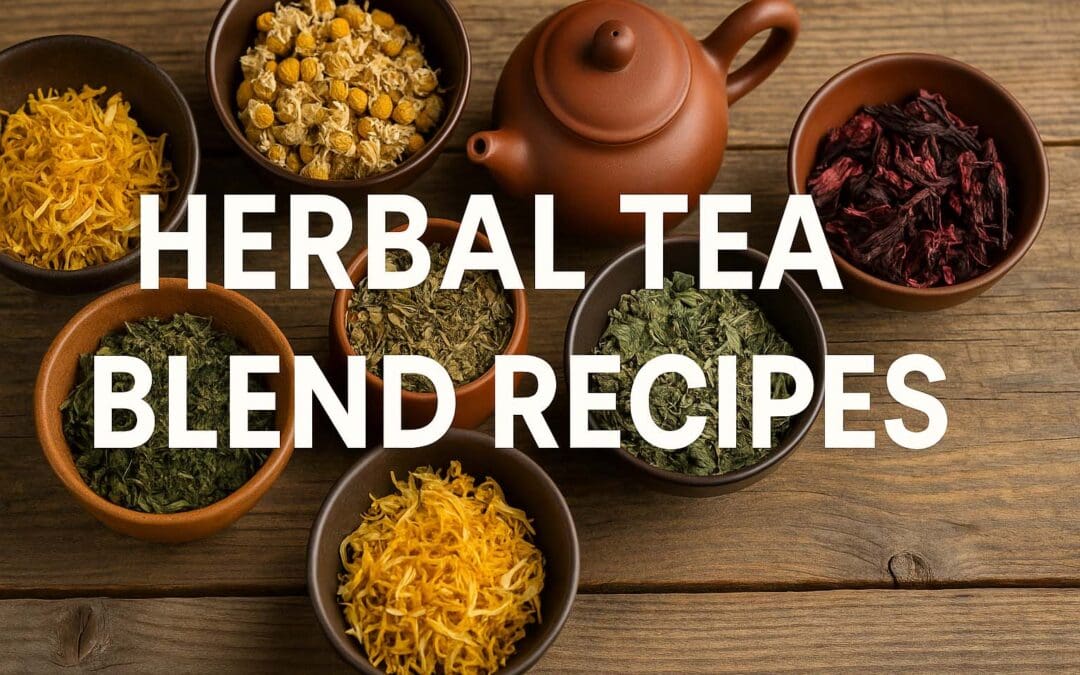Herbal tea has been treasured for centuries as both a soothing ritual and a natural way to support wellness. Today, more people are discovering that herbal tea blends can do so much more than just taste good—they can help calm stress, boost energy, aid digestion, and even strengthen the immune system.
The best part? You don’t have to be an herbalist to enjoy the benefits. With a few simple ingredients, you can create herbal tea blend recipes right at home. And if blending herbs isn’t your thing, you can always enjoy handcrafted teas like our Organic Herbal Tea Collection made right here on our off-grid homestead.
In this post, we’ll share how to build a great blend, six easy herbal tea blend recipes you can try, brewing tips, storage advice, and why small-batch organic teas might be the best option if you’re short on time but still want quality.
What Makes a Good Herbal Tea Blend?
A successful herbal tea blend is all about balance. Think of it like building a recipe: you want a base, accents for flavor, and herbs that bring function.
The Three-Part Framework
Start with a base, add flavor accents, then layer functional herbs for targeted benefits and a cup that tastes great.
Base Herbs
Form the foundation of the cup. Common bases include chamomile, rooibos, green tea, or nettle. They provide body and mouthfeel.
Flavor Herbs
Shape aroma and taste. Try peppermint, spearmint, hibiscus, lemongrass, citrus peel, or lavender for signature notes.
Functional Herbs
Bring purpose to the blend. Ginger (digestive comfort), lemon balm (calm), dandelion root (cleanse), echinacea (seasonal support), and more.
Pro Tip
Keep early blends simple—three herbs is plenty. You can always add complexity later.
Safety Note
If you’re pregnant, nursing, or using medications, consult a healthcare professional before adding new herbs.
6 Herbal Tea Blend Recipes to Try at Home
Each recipe below makes roughly one pot (3–4 cups). Adjust ratios to taste—your ideal balance might be slightly stronger or lighter.
1) Calming Evening Blend
Ingredients
- 2 tsp chamomile
- 1 tsp lemon balm
- ½ tsp lavender
Why It Works
Gentle, floral herbs create a relaxing cup that pairs well with quiet evenings and bedtime rituals.
Brewing Notes
Steep 5–7 minutes in hot (not boiling) water. Cover your cup to capture aromatics.
2) Morning Energy Blend
Ingredients
- 1 tsp yerba mate
- 1 tsp peppermint
- ½ tsp dried orange peel
Why It Works
Bright mint and citrus complement mate’s natural lift for a crisp, focused start—without the coffee crash.
Brewing Notes
Use water just under a boil; steep 4–6 minutes to avoid bitterness.
3) Digestive Comfort Blend
Ingredients
- 1 tsp ginger root
- 1 tsp fennel seed
- 1 tsp peppermint
Why It Works
Warming ginger and aromatic fennel pair with cooling mint for after-meal comfort.
Brewing Notes
Simmer ginger and fennel 5 minutes; remove from heat, add peppermint, steep 3 minutes more.
4) Immune Support Blend
Ingredients
- 1 tsp echinacea
- 1 tsp elderflower
- 1 tsp rose hips
Why It Works
Classic seasonal botanicals with tart rose hips for a pleasant, balancing cup.
Brewing Notes
Steep 7–10 minutes. Sweeten lightly with honey if desired.
5) Detox & Cleanse Blend
Ingredients
- 1 tsp nettle leaf
- 1 tsp dandelion root
- 1 tsp peppermint
Why It Works
Herbs traditionally used for gentle cleansing meet a refreshing mint finish.
Brewing Notes
Simmer dandelion root 5 minutes; add nettle and peppermint off heat, steep 5 minutes.
6) Cooling Summer Blend
Ingredients
- 1 tsp hibiscus
- 1 tsp lemongrass
- ½ tsp spearmint
Why It Works
Tangy hibiscus and citrusy lemongrass meet mellow mint—perfect over ice and rich in antioxidants.
Brewing Notes
Steep 7 minutes; double the herbs for iced tea and pour over plenty of ice.
How to Brew Herbal Tea Blends
Basic Brewing Guidelines
Use 1–2 teaspoons of blend per 8 oz (240 ml) water. Cover while steeping to retain volatile oils and aroma.
Iced Tea Method
Double the herbs, steep strong, then chill or pour over ice. Add citrus slices for brightness.
Strength & Steeping Time
Leaves and flowers: 5–7 minutes. Roots and bark: gently simmer 8–10 minutes before steeping.
Water Temperature Tip
Use hot—but not aggressively boiling—water to avoid bitterness and preserve delicate aromatics.
How to Store Homemade Herbal Tea Blends
Choose the Right Containers
Store in airtight glass jars or tins with tight lids to keep out air and moisture.
Mind the Environment
Keep blends in a cool, dark cabinet. Light, heat, and humidity reduce potency over time.
Label Clearly
Include blend name and the date you mixed it to track freshness and make re-blending easy.
Typical Shelf Life
Most well-stored blends remain vibrant for 6–12 months. Make smaller batches for maximum flavor.
DIY vs. Ready-Made Herbal Teas
DIY blending is fun, but sourcing consistent, organic herbs and dialing in ratios can take time. Ready-made, small-batch teas offer dependable flavor and quality with zero guesswork. If you want a delicious shortcut, browse our handcrafted herbal tea blends—blended and packaged on our homestead.

